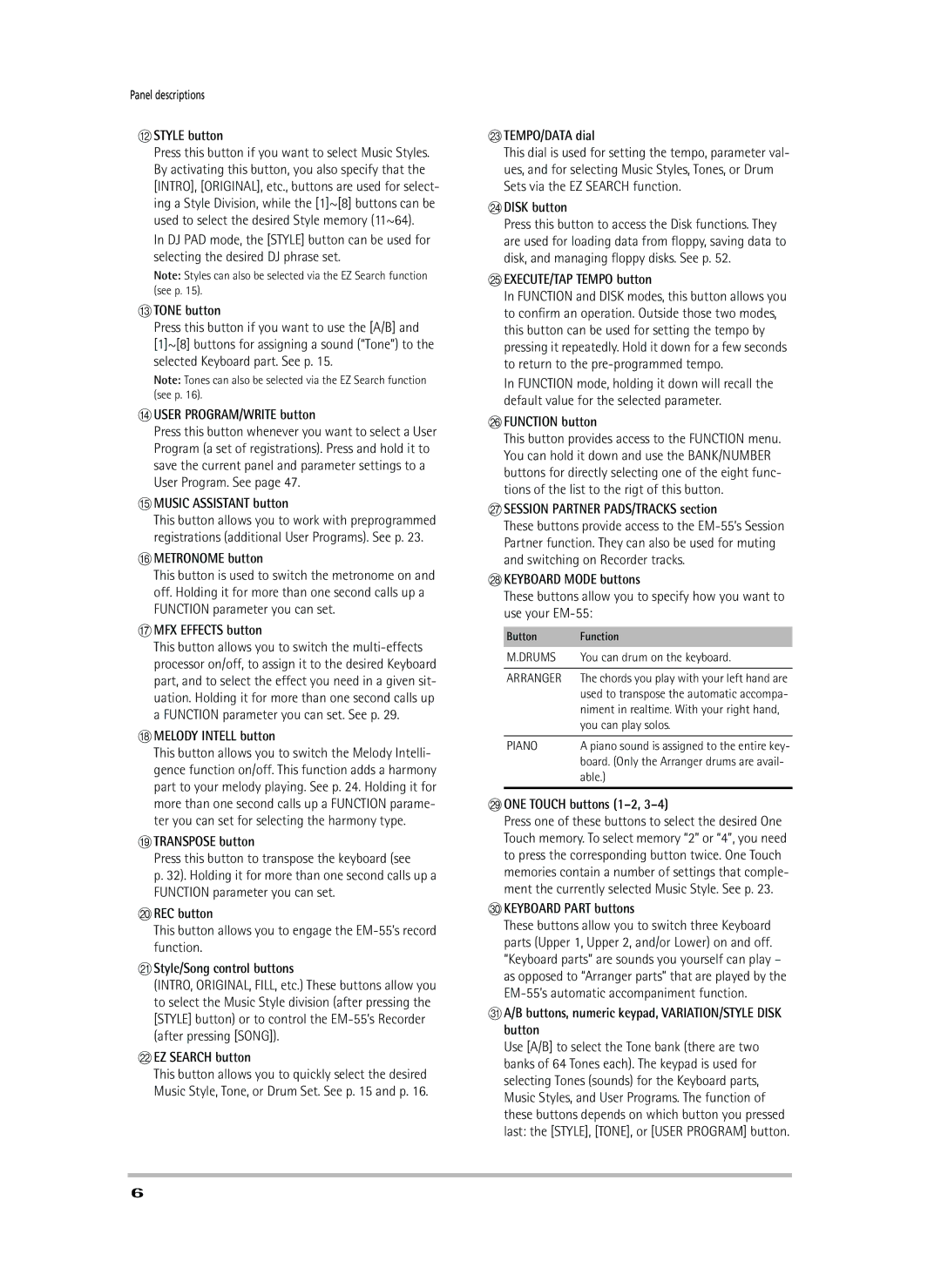
Panel descriptions
LSTYLE button
Press this button if you want to select Music Styles. By activating this button, you also specify that the [INTRO], [ORIGINAL], etc., buttons are used for select- ing a Style Division, while the [1]~[8] buttons can be used to select the desired Style memory (11~64).
In DJ PAD mode, the [STYLE] button can be used for selecting the desired DJ phrase set.
Note: Styles can also be selected via the EZ Search function (see p. 15).
MTONE button
Press this button if you want to use the [A/B] and [1]~[8] buttons for assigning a sound (“Tone”) to the selected Keyboard part. See p. 15.
Note: Tones can also be selected via the EZ Search function (see p. 16).
NUSER PROGRAM/WRITE button
Press this button whenever you want to select a User Program (a set of registrations). Press and hold it to save the current panel and parameter settings to a User Program. See page 47.
OMUSIC ASSISTANT button
This button allows you to work with preprogrammed registrations (additional User Programs). See p. 23.
PMETRONOME button
This button is used to switch the metronome on and off. Holding it for more than one second calls up a FUNCTION parameter you can set.
QMFX EFFECTS button
This button allows you to switch the
RMELODY INTELL button
This button allows you to switch the Melody Intelli- gence function on/off. This function adds a harmony part to your melody playing. See p. 24. Holding it for more than one second calls up a FUNCTION parame- ter you can set for selecting the harmony type.
STRANSPOSE button
Press this button to transpose the keyboard (see
p. 32). Holding it for more than one second calls up a FUNCTION parameter you can set.
TREC button
This button allows you to engage the
UStyle/Song control buttons
(INTRO, ORIGINAL, FILL, etc.) These buttons allow you to select the Music Style division (after pressing the [STYLE] button) or to control the
VEZ SEARCH button
This button allows you to quickly select the desired Music Style, Tone, or Drum Set. See p. 15 and p. 16.
WTEMPO/DATA dial
This dial is used for setting the tempo, parameter val- ues, and for selecting Music Styles, Tones, or Drum Sets via the EZ SEARCH function.
XDISK button
Press this button to access the Disk functions. They are used for loading data from floppy, saving data to disk, and managing floppy disks. See p. 52.
YEXECUTE/TAP TEMPO button
In FUNCTION and DISK modes, this button allows you to confirm an operation. Outside those two modes, this button can be used for setting the tempo by pressing it repeatedly. Hold it down for a few seconds to return to the
In FUNCTION mode, holding it down will recall the default value for the selected parameter.
ZFUNCTION button
This button provides access to the FUNCTION menu. You can hold it down and use the BANK/NUMBER buttons for directly selecting one of the eight func- tions of the list to the rigt of this button.
aSESSION PARTNER PADS/TRACKS section
These buttons provide access to the
bKEYBOARD MODE buttons
These buttons allow you to specify how you want to use your
Button | Function |
M.DRUMS | You can drum on the keyboard. |
|
|
ARRANGER | The chords you play with your left hand are |
| used to transpose the automatic accompa- |
| niment in realtime. With your right hand, |
| you can play solos. |
|
|
PIANO | A piano sound is assigned to the entire key- |
| board. (Only the Arranger drums are avail- |
| able.) |
|
|
cONE TOUCH buttons (1–2, 3–4)
Press one of these buttons to select the desired One Touch memory. To select memory “2” or “4”, you need to press the corresponding button twice. One Touch memories contain a number of settings that comple- ment the currently selected Music Style. See p. 23.
dKEYBOARD PART buttons
These buttons allow you to switch three Keyboard parts (Upper 1, Upper 2, and/or Lower) on and off. “Keyboard parts” are sounds you yourself can play – as opposed to “Arranger parts” that are played by the
eA/B buttons, numeric keypad, VARIATION/STYLE DISK button
Use [A/B] to select the Tone bank (there are two banks of 64 Tones each). The keypad is used for selecting Tones (sounds) for the Keyboard parts, Music Styles, and User Programs. The function of these buttons depends on which button you pressed last: the [STYLE], [TONE], or [USER PROGRAM] button.
6
